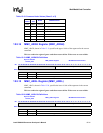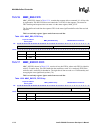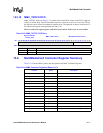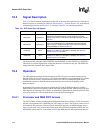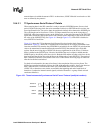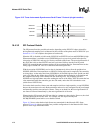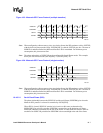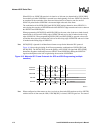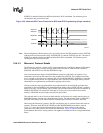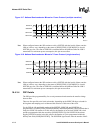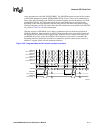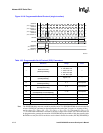
Intel® PXA255 Processor Developer’s Manual 16-5
Network SSP Serial Port
transmit data exist within the transmit FIFO. At other times, SSPSCLK holds in an inactive or idle
state as defined by the protocol.
16.4.3.1 TI Synchronous Serial Protocol* Details
When outgoing data in the SSP controller is ready to transmit, SSPSFRM asserts for one clock
period. On the following clock, data to be transmitted is driven on SSPTXD one bit at a time, the
most significant bit first. For receive data, the peripheral similarly drives data on the SSPRXD pin.
The word length can be from four to 32-bits. All output transitions occur on the rising edge of
SSPSCLK while data sampling occurs on the falling edge. At the end of the transfer, the SSPTXD
signal either retains the value of the last bit sent (LSB) or clears depending on the serial form and
the value of the SSPSP[ETDS] (See Figure 16-1 through Figure 16-8). If the SSP is disabled or
reset, SSPTXD is forced low.
Figure 16-1 shows the TI Synchronous Serial Protocol for when back-to-back frames are
transmitted. Figure 16-2 shows the TI Synchronous Serial Protocol for a single transmitted frame.
Once the transmit FIFO contains data, SSPSFRM is pulsed high for one SSPSCLK period and the
value to be transmitted is transferred from the transmit FIFO to the transmit logic serial shift
register. On the next rising edge of SSPSCLK, the most significant bit of the four to 32-bit data
frame is shifted to the SSPTXD pin. Likewise, the MSB of the received data is shifted onto the
SSPRXD pin by the off-chip serial slave device. Both the SSP and the off-chip serial slave device
then latch each data bit into the serial shifter on the falling edge of each SSPSCLK. The received
data is transferred from the serial shifter to the receive FIFO on the first rising edge of SSPSCLK
after the last bit has been latched.
For back-to-back transfers, the start of one frame is the completion of the previous frame. The
MSB of one transfer immediately follows the LSB of the preceding with no “dead” time between
them. When the SSP is a master to the frame sync (SSPSFRM) and a slave to the clock
(SSPSCLK), at least three extra clocks are needed at the beginning and end of each block of
transfers to synchronize internal control signals (a block of transfers is a group of back-to-back
continuous transfers).
Figure 16-1. Texas Instruments Synchronous Serial Frame* Protocol (multiple transfers)
A9650-01
SSPSCLK
SSPSFRM
SSPTX
Bit[N] Bit[N-1] Bit[1] Bit[0] Bit[N] Bit[N-1] Bit[1]Bit[0]
SSPRX
Bit[N] Bit[N-1] Bit[1] Bit[0] Bit[N] Bit[N-1] Bit[1] Bit[0]
Bit[0]
Bit[0]



